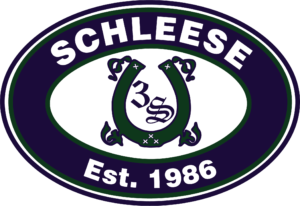Saddle Fit and the Heavier Rider
At the risk of offending any our readers, this is a topic which does need to be addressed in all honesty. I am not trying to insult anyone here, since the issue of proper saddle fit is not by any means limited to heavier riders – all riders and all horses can and will benefit from a correctly fitted saddle! However, heavier riders bring with them a whole different set of challenges (by heavier riders, I am referring to women who are 180+ pounds, and men who are 250+ pounds).
When a heavier rider chooses a horse, it should really be key to have a horse with a large enough saddle support area/weight bearing surface to accommodate a bigger saddle which will fit this rider’s conformational needs. (Think large warmblood type rather than thoroughbred!).
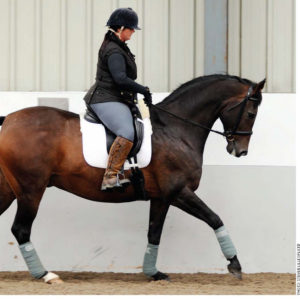 Important is always that the saddle fit the rider first – because if it doesn’t then no matter how well the saddle fits the horse, the rider’s discomfort due to poor rider saddle fit will always translate down to the horse. This limits both the horse and rider in attaining optimum performance. Of course there are certain things that need to be considered in saddle fit to the rider – not least of which is that the saddle accommodates the gender of the rider! There are a number of areas where the saddle needs to fit the rider (just briefly outlined here – and remember that these are ‘in general’ – there are always exceptions!):
Important is always that the saddle fit the rider first – because if it doesn’t then no matter how well the saddle fits the horse, the rider’s discomfort due to poor rider saddle fit will always translate down to the horse. This limits both the horse and rider in attaining optimum performance. Of course there are certain things that need to be considered in saddle fit to the rider – not least of which is that the saddle accommodates the gender of the rider! There are a number of areas where the saddle needs to fit the rider (just briefly outlined here – and remember that these are ‘in general’ – there are always exceptions!):
 Seat size to accommodate the butt cheeks
Seat size to accommodate the butt cheeks- Seat Width to accommodate the wider seat bones
- Seat Waist – the seaming in the crotch area which needs to wider for women so that discomfort in the female genitals can be avoided (and rubbing on the underwear line!) and narrower for men!
- Stirrup Bar Placement (women generally will need extended stirrup bars since their upper legs are usually longer than their lower legs, which affects where the leg hangs)
- Twist (women generally need more narrow twists than men – this is the area of the saddle between the upper inner thighs). This accommodates their hip articulation and angle of the hip socket. Particularly in heavier riders this needs to be super narrow since the thighs will likely be fairly thick.
- Seat Foam – women (with shorter tailbones and higher gluteus muscles) generally need more support from behind so that they don’t ‘fall back’ in the saddle.
Sometimes heavy riders tend to be on horses that are probably questionable in their load bearing capacity…(which is really sad, because we have seen 250+pound riders on skinny little thoroughbreds… however with the right saddle this can be accommodated ‘somewhat’). You need a saddle that accommodates a bigger butt – let’s say 18 ½” – while also having to accommodate a relatively short saddle support are on the horse’s back (let’s say with a 17 ½” panel). This can be done – we say the top of the saddle is for the rider, while the bottom is for the horse.
What are some of the signals that a poor saddle fit may be adding to your horse’s load?
A saddle which is too long for the horse’s back (because most 18 ½ – 19” saddles, which accommodate the heavier rider, likely will be!) can cause bucking, stumbling, rearing, and so on – because the length will be past the saddle support area (which ends at the 18th thoracic vertebra) and onto the ‘bucking reflex’. It will impinge on the kidney area, or the ovaries in a mare. In any case, the horse will react reflexively and instinctively. The back won’t come up; it will be reluctant to move forward. It simply hurts – and horses react to pain (they’re not consciously trying to tick you off!) On more stoic horses, the back will sink into a swayback, effectively doubling the rider`s weight as the rider is unable to swing with the movement of the horse using the natural four curves of her spinal column.
Saddle fit should be checked regularly, regardless whether or not you are a heavier rider or a ‘lighter’ rider! The horse’s conformation will change over time – regardless of the weight of the rider. With a heavier rider, the padding will compress faster – and once the balance is compromised, the rider starts to `clench` and loses the softness of the seat, sitting harder and heavier into the horse`s back.
It does help if a mounting block is used for the rider to get on the horse – but it`s not about the weight; the rule is that the higher the mounting block, the less torque and strain for saddle and horse.
We talk a lot about making sure the saddle fits the horse, but there are some ways to make sure the human fits the saddle. This will only happen if the saddle is made under consideration of the human’s anatomy. Male/female; leg length, leg position (hip articulation), hip circumference, weight – these are all variables that need to be considered when the saddle is built. Obviously, a balanced rider has a better chance of not impacting the horse negatively. To determine rider balance, sit on the saddle on a saddle horse with the saddle sitting backwards on it. Have a friend take a picture and look for these four points to determine how or if the rider is balanced:
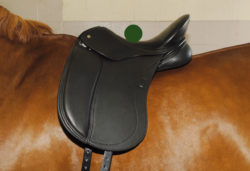 Is there the same amount of saddle flap and seat in front of and behind the leg?
Is there the same amount of saddle flap and seat in front of and behind the leg?- Does the flap length end 4-7“ below the knee cap?
- When viewed at a ¾ angle, does the rider`s leg hang flush with the flap or does the knee and toe turn out to the side?
- Is the rider balanced on her seat bones and does she feel the seat bones without pressure in the crotch – and are the shoulders-hips-heels naturally aligned in the plumb line without help?
Almost more important is truly that the saddle is then adjusted to the horse and its needs are taken into consideration! You need to ensure that the gullet gives the horse enough room all around the withers, so that when the horse is in motion and the muscles begin to ‘grow’ (contract and expand) the saddle doesn’t pinch. The tree points need to have the same angle as the shoulder to allow freedom of movement here as well (think ‘sliding doors’) and not injure the horse by chipping off the sensitive shoulder cartilage.
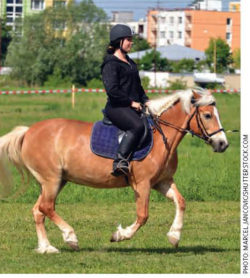 We have all seen horrifying pictures of people riding in saddles that are way too small for them. This will cause damage not only to the horse, but also to the rider. Horse damage can include lameness, sacro-iliac subluxations, vertebrae damage, pinching of nerves along the spinal column and behavioural issues that result from these painful results such as bucking, stumbling, and refusing to work.
We have all seen horrifying pictures of people riding in saddles that are way too small for them. This will cause damage not only to the horse, but also to the rider. Horse damage can include lameness, sacro-iliac subluxations, vertebrae damage, pinching of nerves along the spinal column and behavioural issues that result from these painful results such as bucking, stumbling, and refusing to work.
Human damage can include slipped discs, constant backaches, recurring bladder infections, impotence, and hip damage to the point of requiring hip replacement.
The best analogy of what happens when a saddle is too tight – you will get a blood blister faster on the heel with too tight shoes than if you wore shoes that are too big. If a heavier rider sits in a saddle which is too small, the rider has no chance for a pliable seat and therefore doubles her natural weight. She is not able to swing through her back nor harmonize with the swinging of the horse`s back.
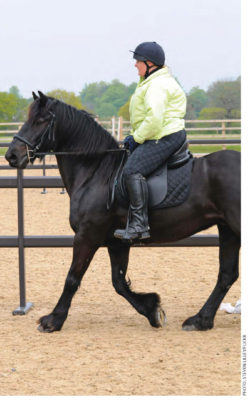 Considering the 9 points of saddle fit, saddle length is critical, as is tree width (not to be mistaken with tree angle). Heavier riders will need softer padding in their panels and sometimes even additional saddle pads (as long as the tree is wide enough to accommodate this extra padding.) Seat size and full panel contact are also important. The heavier the rider – the more of an issue it will be if the saddle bridges. There needs to be accommodation for some ability for the saddle to `rock` with banana-shaped stuffed panels to take care of the extra weight of the rider to avoid digging into the loins or shoulder if the panel is too straight.
Considering the 9 points of saddle fit, saddle length is critical, as is tree width (not to be mistaken with tree angle). Heavier riders will need softer padding in their panels and sometimes even additional saddle pads (as long as the tree is wide enough to accommodate this extra padding.) Seat size and full panel contact are also important. The heavier the rider – the more of an issue it will be if the saddle bridges. There needs to be accommodation for some ability for the saddle to `rock` with banana-shaped stuffed panels to take care of the extra weight of the rider to avoid digging into the loins or shoulder if the panel is too straight.
Let’s remember that horses were not meant to be ridden – we have forced this on them. It is crucial to ensure proper saddle fit to maintain their back health, and it is crucial to ensure the correct saddle for the rider to assist in this. People need to understand that saddles will need to be fitted on a regular basis because due to this unnatural activity and weight on the animal`s back the horse`s conformation will change – and the heavier the rider, the more often the saddle will need to be refitted to the constant change in the shape of the horse`s back.
